Inventory Management Essay and Case Study for Business Development
VerifiedAdded on 2019/09/23
|15
|3121
|223
Essay
AI Summary
This essay and case study analyze the critical aspects of inventory management within the context of logistics and supply chain operations. The essay begins with a discussion on the importance of carefully managing inventories, highlighting the trade-offs between holding surplus stock and the risks of stockouts due to unexpected customer demands or supplier issues. It then delves into the pitfalls of poor inventory management, such as lack of supply chain metrics, inadequate customer service definitions, inaccurate delivery data, inefficient information systems, and ignoring uncertainties. The essay also addresses the importance of organizational coordination, proper assessment of inventory costs, and the separation of supply chain design from operational decisions. The second part of the essay presents a case study of WCC North America, examining critical issues in logistics management, recommending changes to address these issues, assessing perceived risks and benefits, and evaluating the impact of proposed changes on WCC's operations. The recommended changes include improved communication, removal of communication barriers, and the implementation of customer feedback mechanisms. The document concludes with a call for a balance between cost reduction and the benefits derived from improved customer and vendor relations, ultimately emphasizing the need for efficient management coordination to ensure timely stock flow, customer satisfaction, and waste reduction.
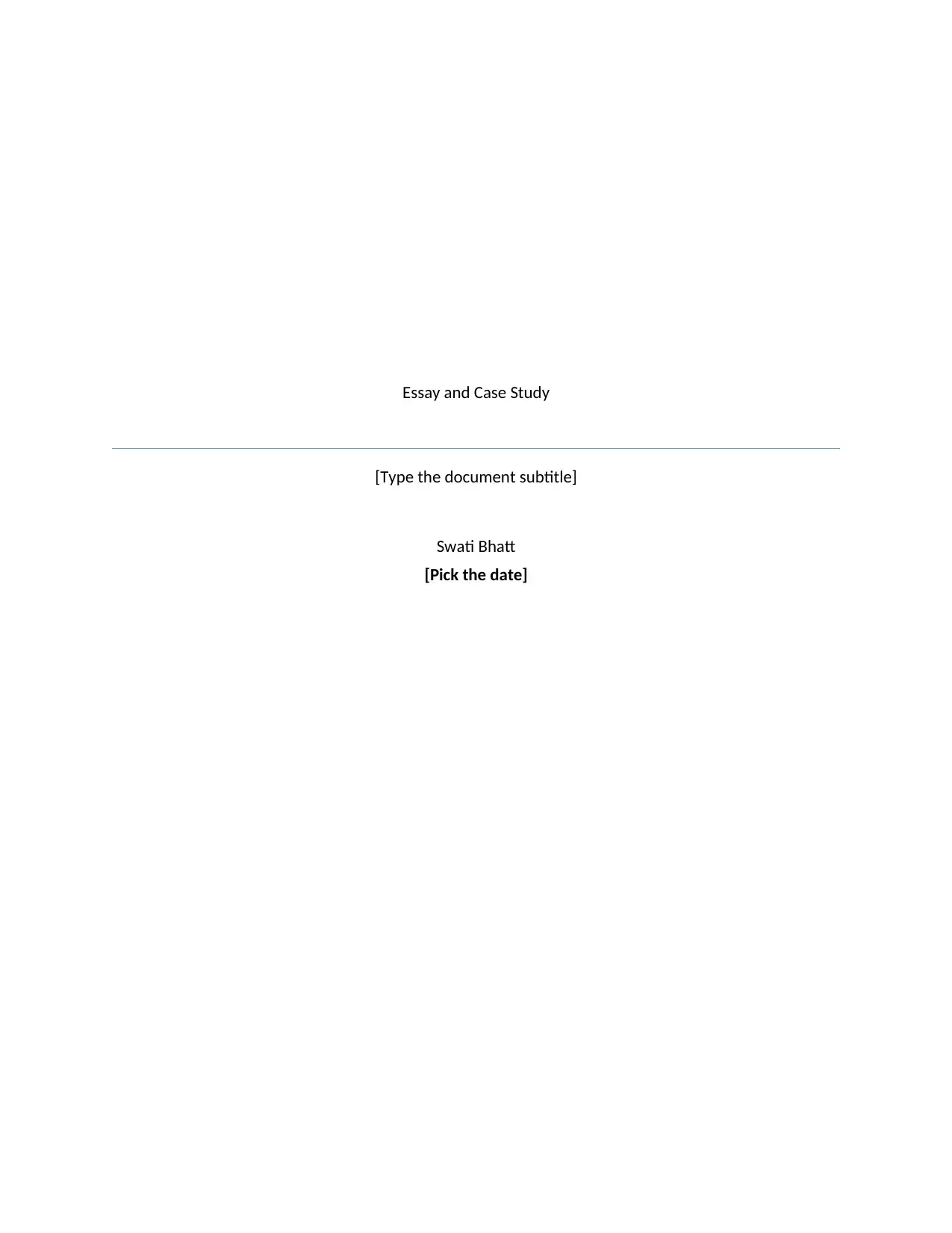
Essay and Case Study
[Type the document subtitle]
Swati Bhatt
[Pick the date]
[Type the document subtitle]
Swati Bhatt
[Pick the date]
Paraphrase This Document
Need a fresh take? Get an instant paraphrase of this document with our AI Paraphraser

Question 1
Essay
“Although there are good reasons to keep inventories in the
logistics chain, they must be carefully managed.”
Keeping surplus inventories in stock is always not a lucrative option for a businessman, but
sometimes excess is always not a need of an hour due to unexpected customer demands &
supplier inadequate supply. Keeping this in mind, the businessman should judiciously optimize
their stock requirement & keep on circulating stocks. There are various ways to measure pitfalls
& advantages with logistics chains (Nabo, 2013). In the today’s modern world of retailing &
whole selling, smooth inflow & outflow measures the inventory levels. Through an Optimization
and proper Coordination between various departments & divisions is the sign of a proper
integration within the company. This cooperation helps in a smooth flow, reduced costs & better
working style prospects. For example, a customer wants a new shirt & he will order with a
company, so the company has to check for stock, raw material availability, transportation costs
& then will check for delivery status. If the inventory & availability of stock is not there, then it
would lead to delays & loss of customers.
If at all inventory has to be maintained then costs & trade-offs has closely monitored. The
company has the focus on the inventory ratios which means the company is optimally utilizing
1
Essay
“Although there are good reasons to keep inventories in the
logistics chain, they must be carefully managed.”
Keeping surplus inventories in stock is always not a lucrative option for a businessman, but
sometimes excess is always not a need of an hour due to unexpected customer demands &
supplier inadequate supply. Keeping this in mind, the businessman should judiciously optimize
their stock requirement & keep on circulating stocks. There are various ways to measure pitfalls
& advantages with logistics chains (Nabo, 2013). In the today’s modern world of retailing &
whole selling, smooth inflow & outflow measures the inventory levels. Through an Optimization
and proper Coordination between various departments & divisions is the sign of a proper
integration within the company. This cooperation helps in a smooth flow, reduced costs & better
working style prospects. For example, a customer wants a new shirt & he will order with a
company, so the company has to check for stock, raw material availability, transportation costs
& then will check for delivery status. If the inventory & availability of stock is not there, then it
would lead to delays & loss of customers.
If at all inventory has to be maintained then costs & trade-offs has closely monitored. The
company has the focus on the inventory ratios which means the company is optimally utilizing
1
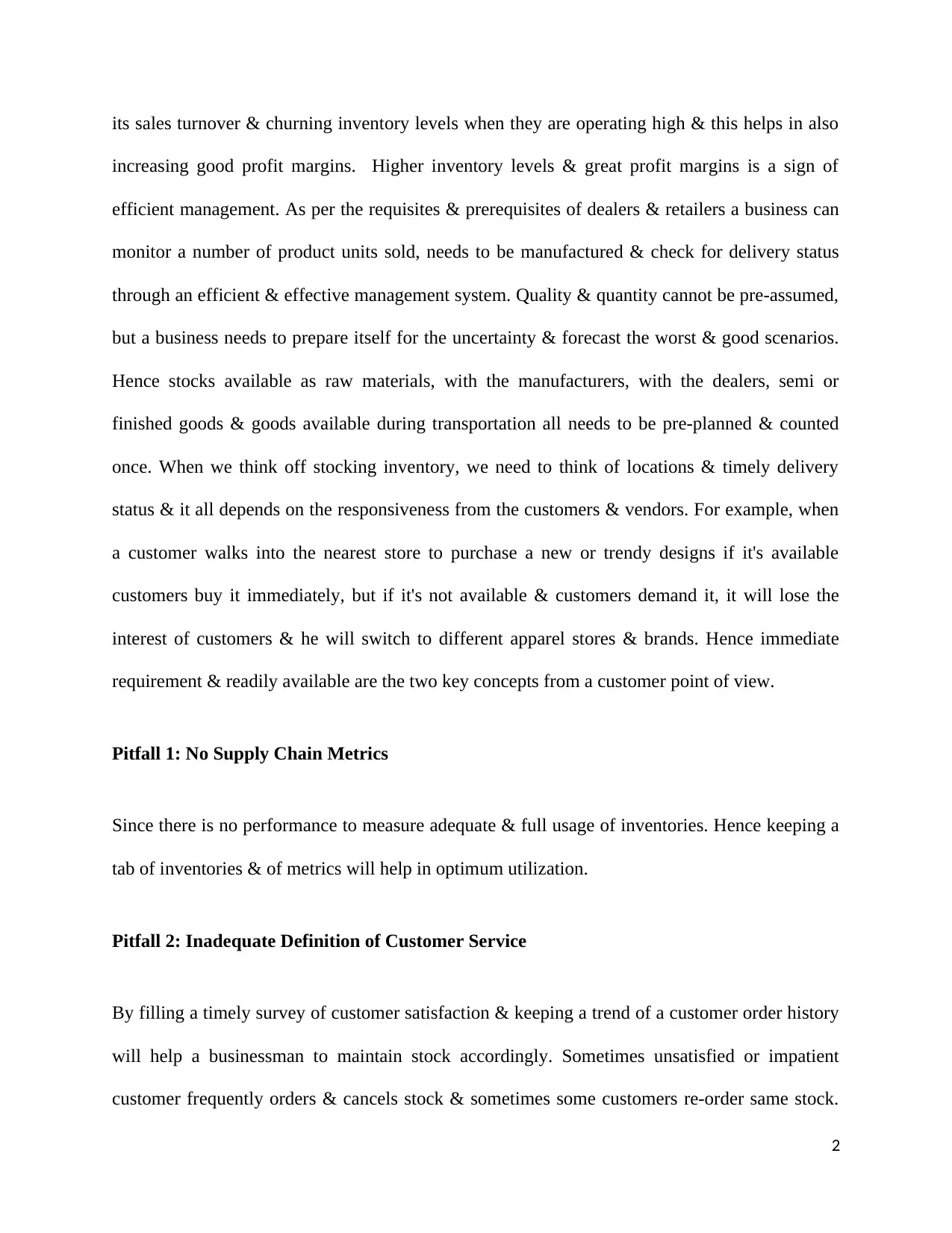
its sales turnover & churning inventory levels when they are operating high & this helps in also
increasing good profit margins. Higher inventory levels & great profit margins is a sign of
efficient management. As per the requisites & prerequisites of dealers & retailers a business can
monitor a number of product units sold, needs to be manufactured & check for delivery status
through an efficient & effective management system. Quality & quantity cannot be pre-assumed,
but a business needs to prepare itself for the uncertainty & forecast the worst & good scenarios.
Hence stocks available as raw materials, with the manufacturers, with the dealers, semi or
finished goods & goods available during transportation all needs to be pre-planned & counted
once. When we think off stocking inventory, we need to think of locations & timely delivery
status & it all depends on the responsiveness from the customers & vendors. For example, when
a customer walks into the nearest store to purchase a new or trendy designs if it's available
customers buy it immediately, but if it's not available & customers demand it, it will lose the
interest of customers & he will switch to different apparel stores & brands. Hence immediate
requirement & readily available are the two key concepts from a customer point of view.
Pitfall 1: No Supply Chain Metrics
Since there is no performance to measure adequate & full usage of inventories. Hence keeping a
tab of inventories & of metrics will help in optimum utilization.
Pitfall 2: Inadequate Definition of Customer Service
By filling a timely survey of customer satisfaction & keeping a trend of a customer order history
will help a businessman to maintain stock accordingly. Sometimes unsatisfied or impatient
customer frequently orders & cancels stock & sometimes some customers re-order same stock.
2
increasing good profit margins. Higher inventory levels & great profit margins is a sign of
efficient management. As per the requisites & prerequisites of dealers & retailers a business can
monitor a number of product units sold, needs to be manufactured & check for delivery status
through an efficient & effective management system. Quality & quantity cannot be pre-assumed,
but a business needs to prepare itself for the uncertainty & forecast the worst & good scenarios.
Hence stocks available as raw materials, with the manufacturers, with the dealers, semi or
finished goods & goods available during transportation all needs to be pre-planned & counted
once. When we think off stocking inventory, we need to think of locations & timely delivery
status & it all depends on the responsiveness from the customers & vendors. For example, when
a customer walks into the nearest store to purchase a new or trendy designs if it's available
customers buy it immediately, but if it's not available & customers demand it, it will lose the
interest of customers & he will switch to different apparel stores & brands. Hence immediate
requirement & readily available are the two key concepts from a customer point of view.
Pitfall 1: No Supply Chain Metrics
Since there is no performance to measure adequate & full usage of inventories. Hence keeping a
tab of inventories & of metrics will help in optimum utilization.
Pitfall 2: Inadequate Definition of Customer Service
By filling a timely survey of customer satisfaction & keeping a trend of a customer order history
will help a businessman to maintain stock accordingly. Sometimes unsatisfied or impatient
customer frequently orders & cancels stock & sometimes some customers re-order same stock.
2
⊘ This is a preview!⊘
Do you want full access?
Subscribe today to unlock all pages.

Trusted by 1+ million students worldwide
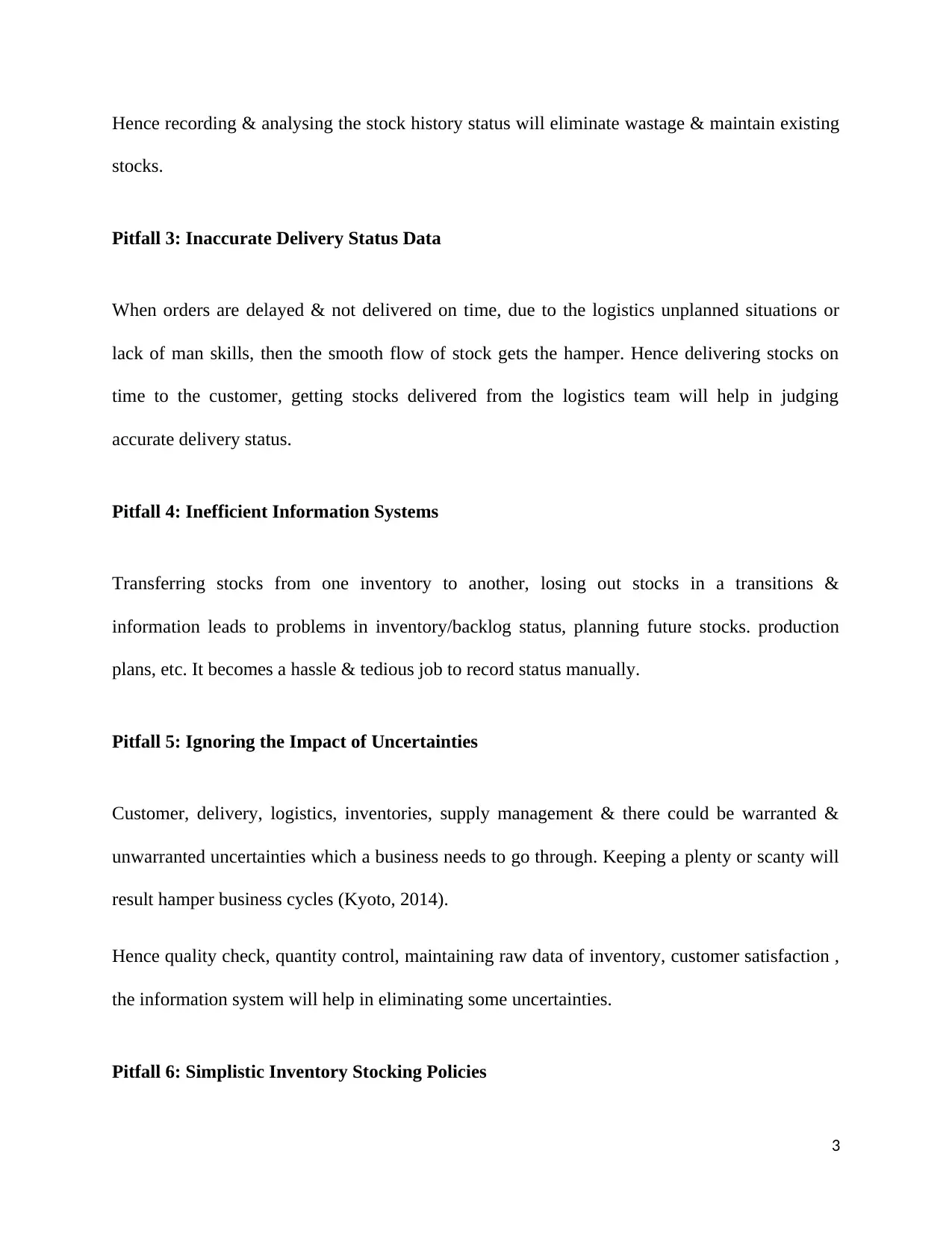
Hence recording & analysing the stock history status will eliminate wastage & maintain existing
stocks.
Pitfall 3: Inaccurate Delivery Status Data
When orders are delayed & not delivered on time, due to the logistics unplanned situations or
lack of man skills, then the smooth flow of stock gets the hamper. Hence delivering stocks on
time to the customer, getting stocks delivered from the logistics team will help in judging
accurate delivery status.
Pitfall 4: Inefficient Information Systems
Transferring stocks from one inventory to another, losing out stocks in a transitions &
information leads to problems in inventory/backlog status, planning future stocks. production
plans, etc. It becomes a hassle & tedious job to record status manually.
Pitfall 5: Ignoring the Impact of Uncertainties
Customer, delivery, logistics, inventories, supply management & there could be warranted &
unwarranted uncertainties which a business needs to go through. Keeping a plenty or scanty will
result hamper business cycles (Kyoto, 2014).
Hence quality check, quantity control, maintaining raw data of inventory, customer satisfaction ,
the information system will help in eliminating some uncertainties.
Pitfall 6: Simplistic Inventory Stocking Policies
3
stocks.
Pitfall 3: Inaccurate Delivery Status Data
When orders are delayed & not delivered on time, due to the logistics unplanned situations or
lack of man skills, then the smooth flow of stock gets the hamper. Hence delivering stocks on
time to the customer, getting stocks delivered from the logistics team will help in judging
accurate delivery status.
Pitfall 4: Inefficient Information Systems
Transferring stocks from one inventory to another, losing out stocks in a transitions &
information leads to problems in inventory/backlog status, planning future stocks. production
plans, etc. It becomes a hassle & tedious job to record status manually.
Pitfall 5: Ignoring the Impact of Uncertainties
Customer, delivery, logistics, inventories, supply management & there could be warranted &
unwarranted uncertainties which a business needs to go through. Keeping a plenty or scanty will
result hamper business cycles (Kyoto, 2014).
Hence quality check, quantity control, maintaining raw data of inventory, customer satisfaction ,
the information system will help in eliminating some uncertainties.
Pitfall 6: Simplistic Inventory Stocking Policies
3
Paraphrase This Document
Need a fresh take? Get an instant paraphrase of this document with our AI Paraphraser
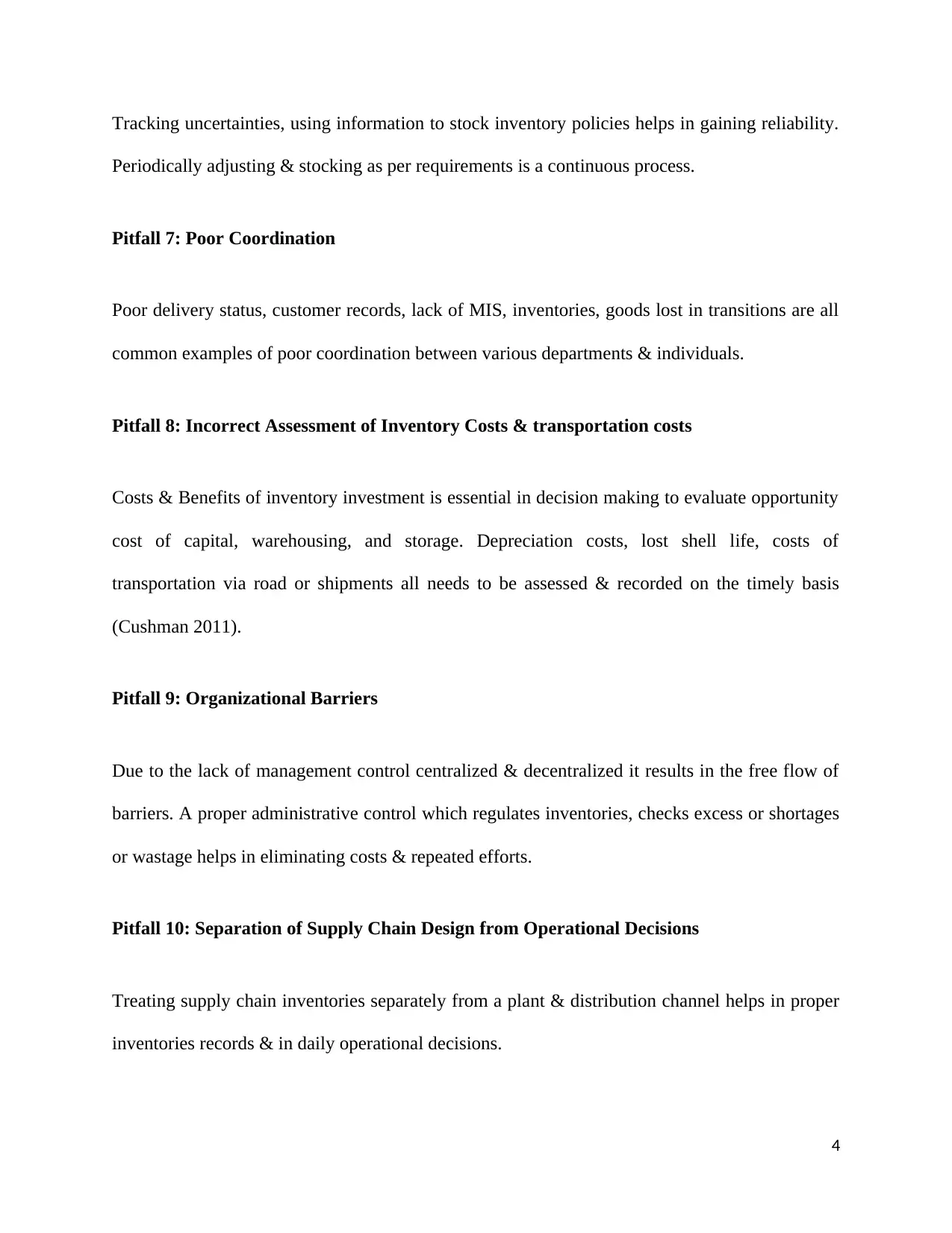
Tracking uncertainties, using information to stock inventory policies helps in gaining reliability.
Periodically adjusting & stocking as per requirements is a continuous process.
Pitfall 7: Poor Coordination
Poor delivery status, customer records, lack of MIS, inventories, goods lost in transitions are all
common examples of poor coordination between various departments & individuals.
Pitfall 8: Incorrect Assessment of Inventory Costs & transportation costs
Costs & Benefits of inventory investment is essential in decision making to evaluate opportunity
cost of capital, warehousing, and storage. Depreciation costs, lost shell life, costs of
transportation via road or shipments all needs to be assessed & recorded on the timely basis
(Cushman 2011).
Pitfall 9: Organizational Barriers
Due to the lack of management control centralized & decentralized it results in the free flow of
barriers. A proper administrative control which regulates inventories, checks excess or shortages
or wastage helps in eliminating costs & repeated efforts.
Pitfall 10: Separation of Supply Chain Design from Operational Decisions
Treating supply chain inventories separately from a plant & distribution channel helps in proper
inventories records & in daily operational decisions.
4
Periodically adjusting & stocking as per requirements is a continuous process.
Pitfall 7: Poor Coordination
Poor delivery status, customer records, lack of MIS, inventories, goods lost in transitions are all
common examples of poor coordination between various departments & individuals.
Pitfall 8: Incorrect Assessment of Inventory Costs & transportation costs
Costs & Benefits of inventory investment is essential in decision making to evaluate opportunity
cost of capital, warehousing, and storage. Depreciation costs, lost shell life, costs of
transportation via road or shipments all needs to be assessed & recorded on the timely basis
(Cushman 2011).
Pitfall 9: Organizational Barriers
Due to the lack of management control centralized & decentralized it results in the free flow of
barriers. A proper administrative control which regulates inventories, checks excess or shortages
or wastage helps in eliminating costs & repeated efforts.
Pitfall 10: Separation of Supply Chain Design from Operational Decisions
Treating supply chain inventories separately from a plant & distribution channel helps in proper
inventories records & in daily operational decisions.
4
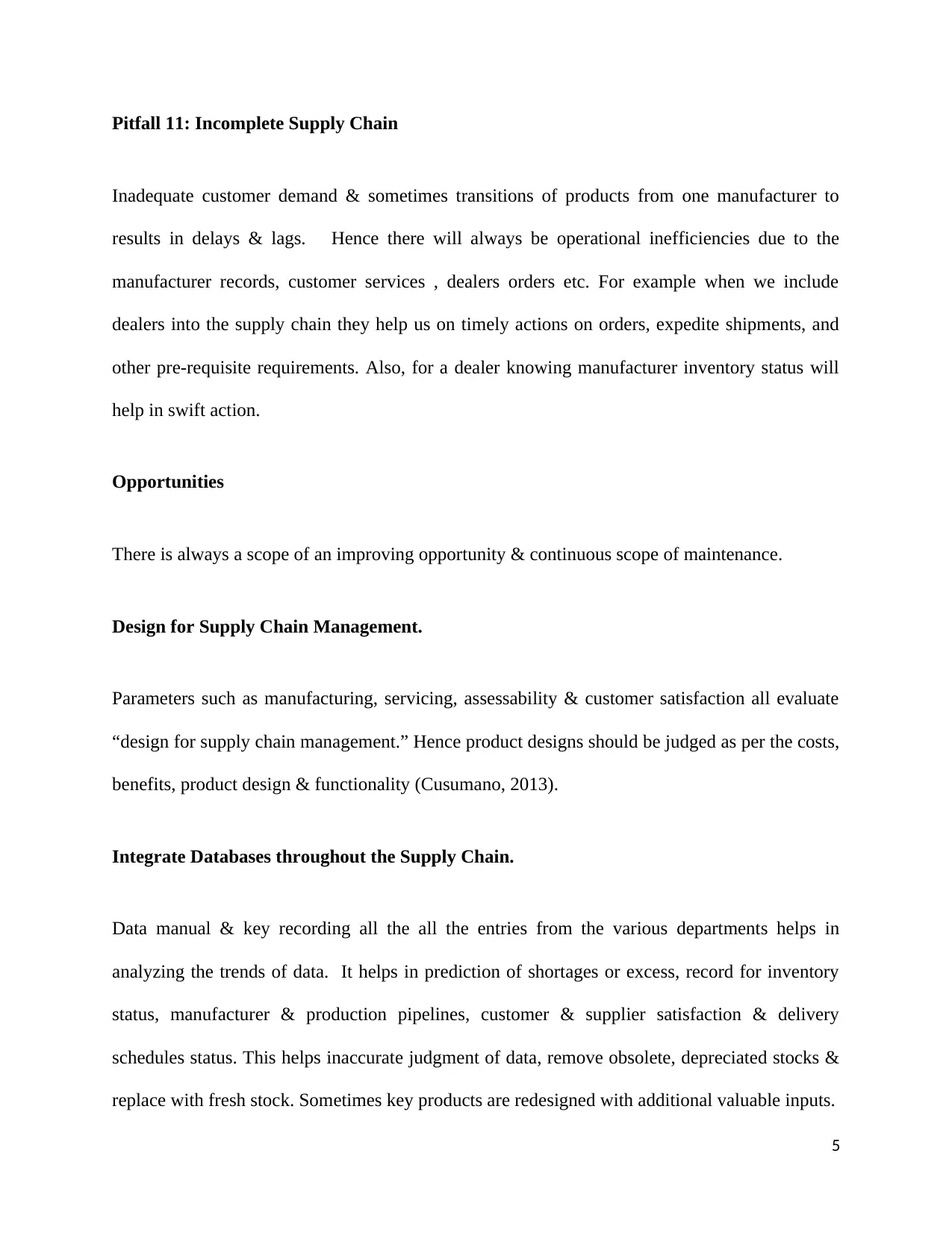
Pitfall 11: Incomplete Supply Chain
Inadequate customer demand & sometimes transitions of products from one manufacturer to
results in delays & lags. Hence there will always be operational inefficiencies due to the
manufacturer records, customer services , dealers orders etc. For example when we include
dealers into the supply chain they help us on timely actions on orders, expedite shipments, and
other pre-requisite requirements. Also, for a dealer knowing manufacturer inventory status will
help in swift action.
Opportunities
There is always a scope of an improving opportunity & continuous scope of maintenance.
Design for Supply Chain Management.
Parameters such as manufacturing, servicing, assessability & customer satisfaction all evaluate
“design for supply chain management.” Hence product designs should be judged as per the costs,
benefits, product design & functionality (Cusumano, 2013).
Integrate Databases throughout the Supply Chain.
Data manual & key recording all the all the entries from the various departments helps in
analyzing the trends of data. It helps in prediction of shortages or excess, record for inventory
status, manufacturer & production pipelines, customer & supplier satisfaction & delivery
schedules status. This helps inaccurate judgment of data, remove obsolete, depreciated stocks &
replace with fresh stock. Sometimes key products are redesigned with additional valuable inputs.
5
Inadequate customer demand & sometimes transitions of products from one manufacturer to
results in delays & lags. Hence there will always be operational inefficiencies due to the
manufacturer records, customer services , dealers orders etc. For example when we include
dealers into the supply chain they help us on timely actions on orders, expedite shipments, and
other pre-requisite requirements. Also, for a dealer knowing manufacturer inventory status will
help in swift action.
Opportunities
There is always a scope of an improving opportunity & continuous scope of maintenance.
Design for Supply Chain Management.
Parameters such as manufacturing, servicing, assessability & customer satisfaction all evaluate
“design for supply chain management.” Hence product designs should be judged as per the costs,
benefits, product design & functionality (Cusumano, 2013).
Integrate Databases throughout the Supply Chain.
Data manual & key recording all the all the entries from the various departments helps in
analyzing the trends of data. It helps in prediction of shortages or excess, record for inventory
status, manufacturer & production pipelines, customer & supplier satisfaction & delivery
schedules status. This helps inaccurate judgment of data, remove obsolete, depreciated stocks &
replace with fresh stock. Sometimes key products are redesigned with additional valuable inputs.
5
⊘ This is a preview!⊘
Do you want full access?
Subscribe today to unlock all pages.

Trusted by 1+ million students worldwide
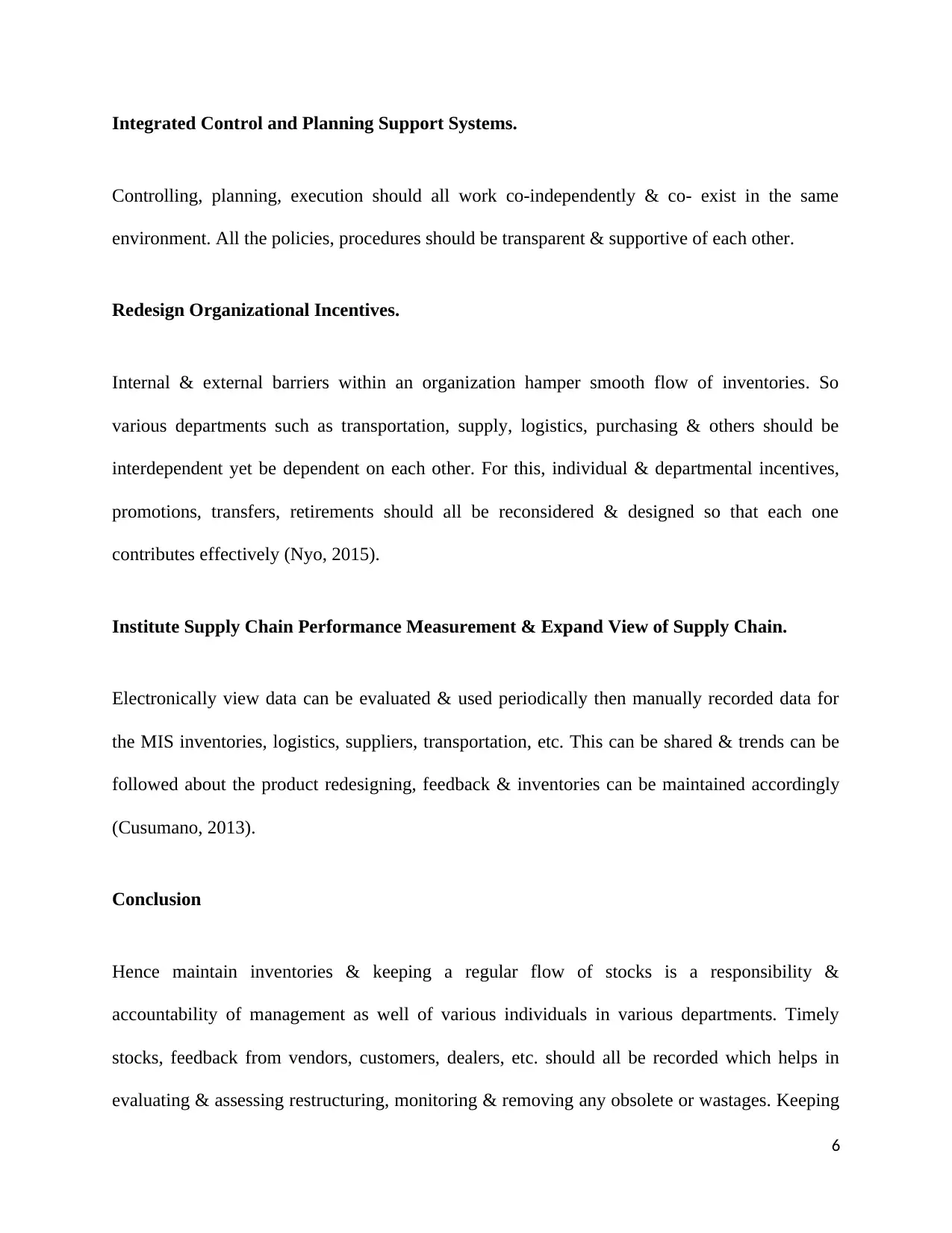
Integrated Control and Planning Support Systems.
Controlling, planning, execution should all work co-independently & co- exist in the same
environment. All the policies, procedures should be transparent & supportive of each other.
Redesign Organizational Incentives.
Internal & external barriers within an organization hamper smooth flow of inventories. So
various departments such as transportation, supply, logistics, purchasing & others should be
interdependent yet be dependent on each other. For this, individual & departmental incentives,
promotions, transfers, retirements should all be reconsidered & designed so that each one
contributes effectively (Nyo, 2015).
Institute Supply Chain Performance Measurement & Expand View of Supply Chain.
Electronically view data can be evaluated & used periodically then manually recorded data for
the MIS inventories, logistics, suppliers, transportation, etc. This can be shared & trends can be
followed about the product redesigning, feedback & inventories can be maintained accordingly
(Cusumano, 2013).
Conclusion
Hence maintain inventories & keeping a regular flow of stocks is a responsibility &
accountability of management as well of various individuals in various departments. Timely
stocks, feedback from vendors, customers, dealers, etc. should all be recorded which helps in
evaluating & assessing restructuring, monitoring & removing any obsolete or wastages. Keeping
6
Controlling, planning, execution should all work co-independently & co- exist in the same
environment. All the policies, procedures should be transparent & supportive of each other.
Redesign Organizational Incentives.
Internal & external barriers within an organization hamper smooth flow of inventories. So
various departments such as transportation, supply, logistics, purchasing & others should be
interdependent yet be dependent on each other. For this, individual & departmental incentives,
promotions, transfers, retirements should all be reconsidered & designed so that each one
contributes effectively (Nyo, 2015).
Institute Supply Chain Performance Measurement & Expand View of Supply Chain.
Electronically view data can be evaluated & used periodically then manually recorded data for
the MIS inventories, logistics, suppliers, transportation, etc. This can be shared & trends can be
followed about the product redesigning, feedback & inventories can be maintained accordingly
(Cusumano, 2013).
Conclusion
Hence maintain inventories & keeping a regular flow of stocks is a responsibility &
accountability of management as well of various individuals in various departments. Timely
stocks, feedback from vendors, customers, dealers, etc. should all be recorded which helps in
evaluating & assessing restructuring, monitoring & removing any obsolete or wastages. Keeping
6
Paraphrase This Document
Need a fresh take? Get an instant paraphrase of this document with our AI Paraphraser
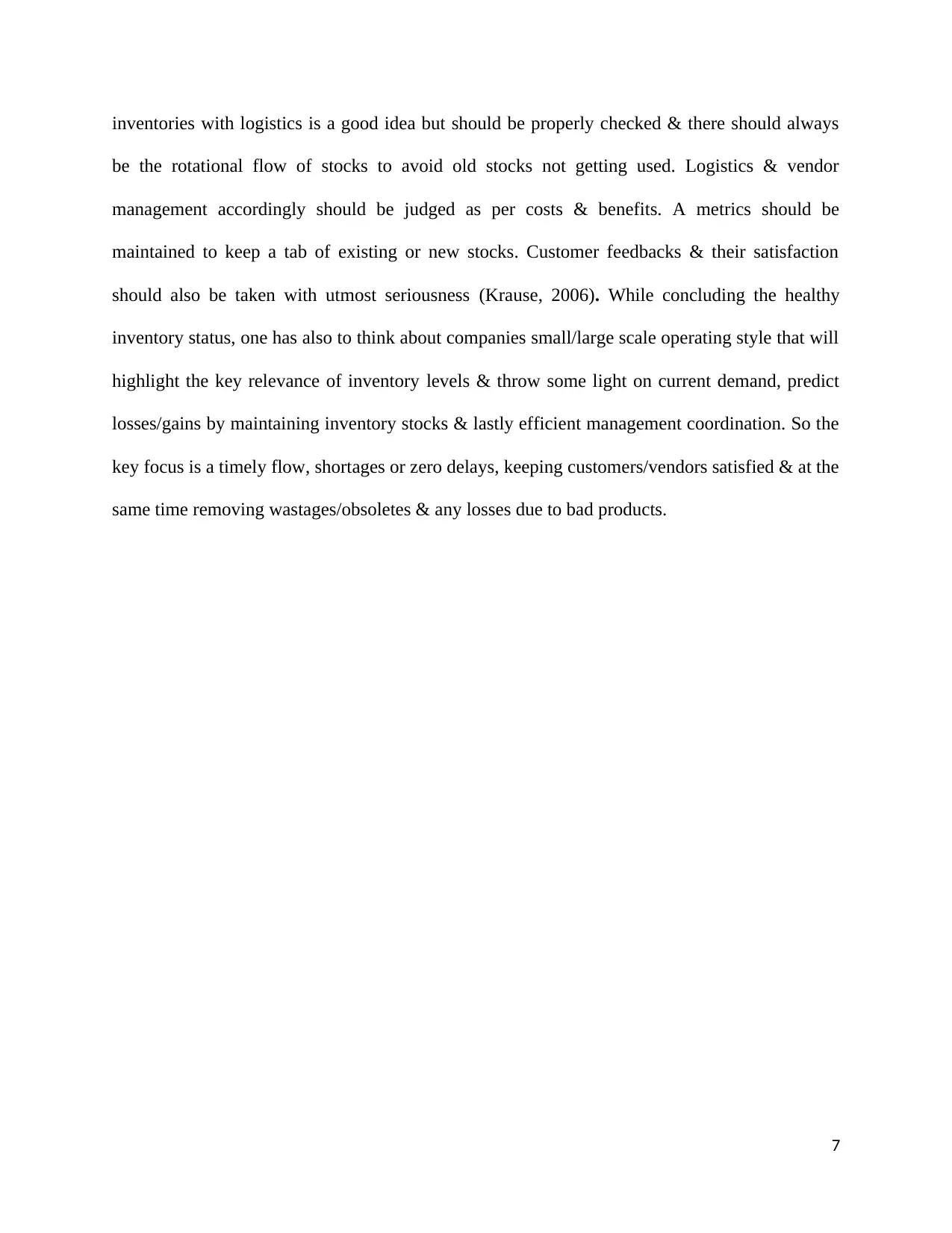
inventories with logistics is a good idea but should be properly checked & there should always
be the rotational flow of stocks to avoid old stocks not getting used. Logistics & vendor
management accordingly should be judged as per costs & benefits. A metrics should be
maintained to keep a tab of existing or new stocks. Customer feedbacks & their satisfaction
should also be taken with utmost seriousness (Krause, 2006). While concluding the healthy
inventory status, one has also to think about companies small/large scale operating style that will
highlight the key relevance of inventory levels & throw some light on current demand, predict
losses/gains by maintaining inventory stocks & lastly efficient management coordination. So the
key focus is a timely flow, shortages or zero delays, keeping customers/vendors satisfied & at the
same time removing wastages/obsoletes & any losses due to bad products.
7
be the rotational flow of stocks to avoid old stocks not getting used. Logistics & vendor
management accordingly should be judged as per costs & benefits. A metrics should be
maintained to keep a tab of existing or new stocks. Customer feedbacks & their satisfaction
should also be taken with utmost seriousness (Krause, 2006). While concluding the healthy
inventory status, one has also to think about companies small/large scale operating style that will
highlight the key relevance of inventory levels & throw some light on current demand, predict
losses/gains by maintaining inventory stocks & lastly efficient management coordination. So the
key focus is a timely flow, shortages or zero delays, keeping customers/vendors satisfied & at the
same time removing wastages/obsoletes & any losses due to bad products.
7
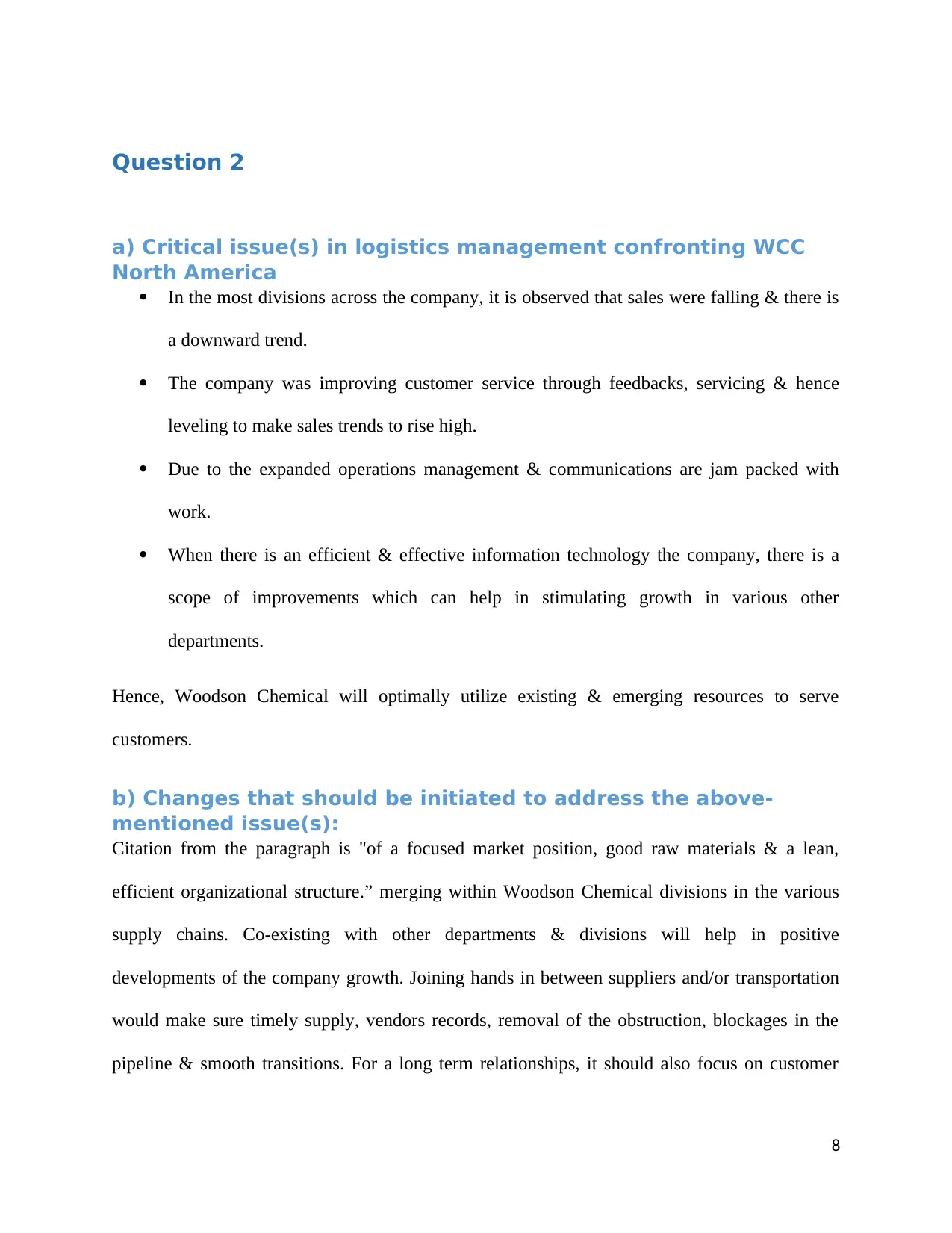
Question 2
a) Critical issue(s) in logistics management confronting WCC
North America
In the most divisions across the company, it is observed that sales were falling & there is
a downward trend.
The company was improving customer service through feedbacks, servicing & hence
leveling to make sales trends to rise high.
Due to the expanded operations management & communications are jam packed with
work.
When there is an efficient & effective information technology the company, there is a
scope of improvements which can help in stimulating growth in various other
departments.
Hence, Woodson Chemical will optimally utilize existing & emerging resources to serve
customers.
b) Changes that should be initiated to address the above-
mentioned issue(s):
Citation from the paragraph is "of a focused market position, good raw materials & a lean,
efficient organizational structure.” merging within Woodson Chemical divisions in the various
supply chains. Co-existing with other departments & divisions will help in positive
developments of the company growth. Joining hands in between suppliers and/or transportation
would make sure timely supply, vendors records, removal of the obstruction, blockages in the
pipeline & smooth transitions. For a long term relationships, it should also focus on customer
8
a) Critical issue(s) in logistics management confronting WCC
North America
In the most divisions across the company, it is observed that sales were falling & there is
a downward trend.
The company was improving customer service through feedbacks, servicing & hence
leveling to make sales trends to rise high.
Due to the expanded operations management & communications are jam packed with
work.
When there is an efficient & effective information technology the company, there is a
scope of improvements which can help in stimulating growth in various other
departments.
Hence, Woodson Chemical will optimally utilize existing & emerging resources to serve
customers.
b) Changes that should be initiated to address the above-
mentioned issue(s):
Citation from the paragraph is "of a focused market position, good raw materials & a lean,
efficient organizational structure.” merging within Woodson Chemical divisions in the various
supply chains. Co-existing with other departments & divisions will help in positive
developments of the company growth. Joining hands in between suppliers and/or transportation
would make sure timely supply, vendors records, removal of the obstruction, blockages in the
pipeline & smooth transitions. For a long term relationships, it should also focus on customer
8
⊘ This is a preview!⊘
Do you want full access?
Subscribe today to unlock all pages.

Trusted by 1+ million students worldwide
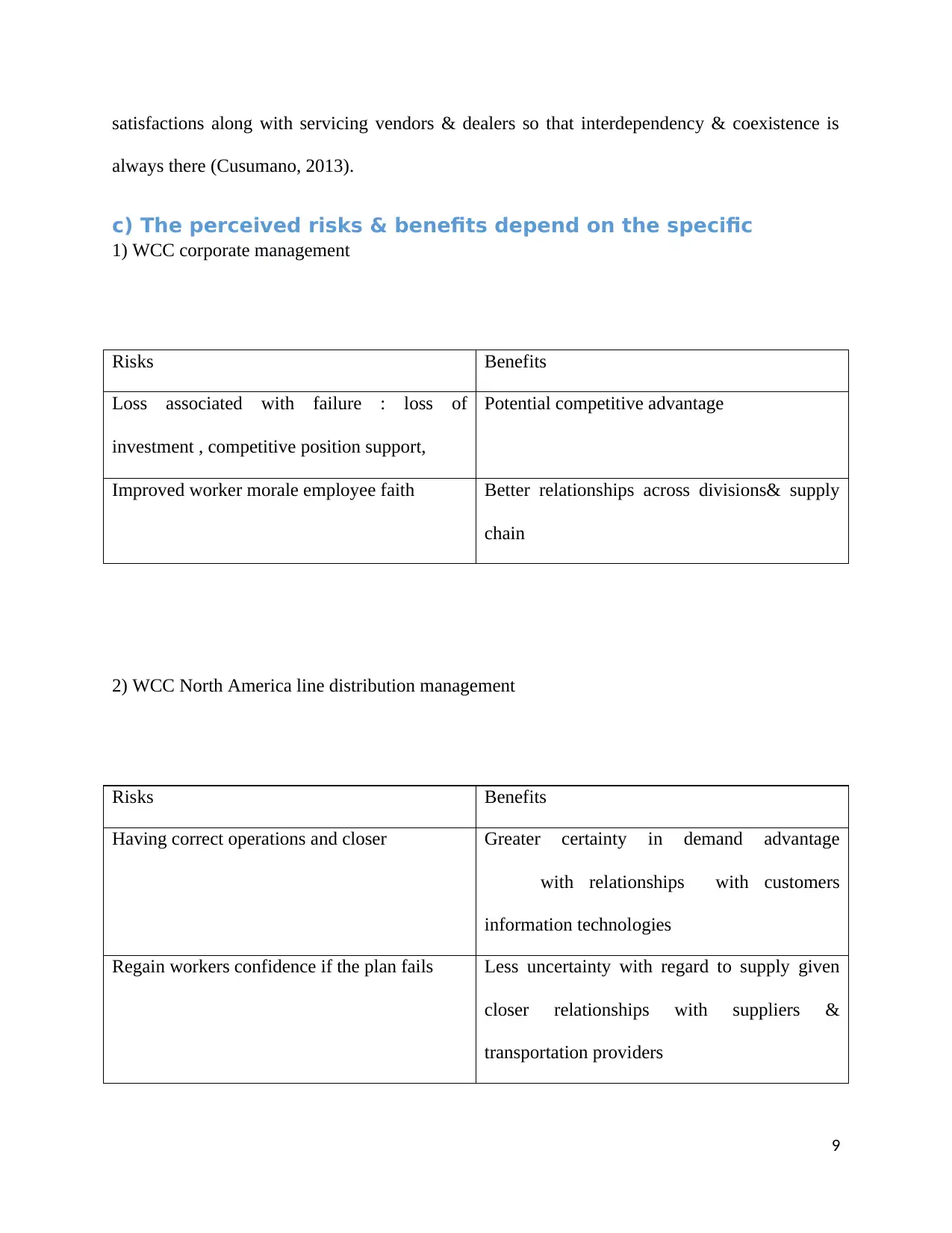
satisfactions along with servicing vendors & dealers so that interdependency & coexistence is
always there (Cusumano, 2013).
c) The perceived risks & benefits depend on the specific
1) WCC corporate management
Risks Benefits
Loss associated with failure : loss of
investment , competitive position support,
Potential competitive advantage
Improved worker morale employee faith Better relationships across divisions& supply
chain
2) WCC North America line distribution management
Risks Benefits
Having correct operations and closer Greater certainty in demand advantage
with relationships with customers
information technologies
Regain workers confidence if the plan fails Less uncertainty with regard to supply given
closer relationships with suppliers &
transportation providers
9
always there (Cusumano, 2013).
c) The perceived risks & benefits depend on the specific
1) WCC corporate management
Risks Benefits
Loss associated with failure : loss of
investment , competitive position support,
Potential competitive advantage
Improved worker morale employee faith Better relationships across divisions& supply
chain
2) WCC North America line distribution management
Risks Benefits
Having correct operations and closer Greater certainty in demand advantage
with relationships with customers
information technologies
Regain workers confidence if the plan fails Less uncertainty with regard to supply given
closer relationships with suppliers &
transportation providers
9
Paraphrase This Document
Need a fresh take? Get an instant paraphrase of this document with our AI Paraphraser
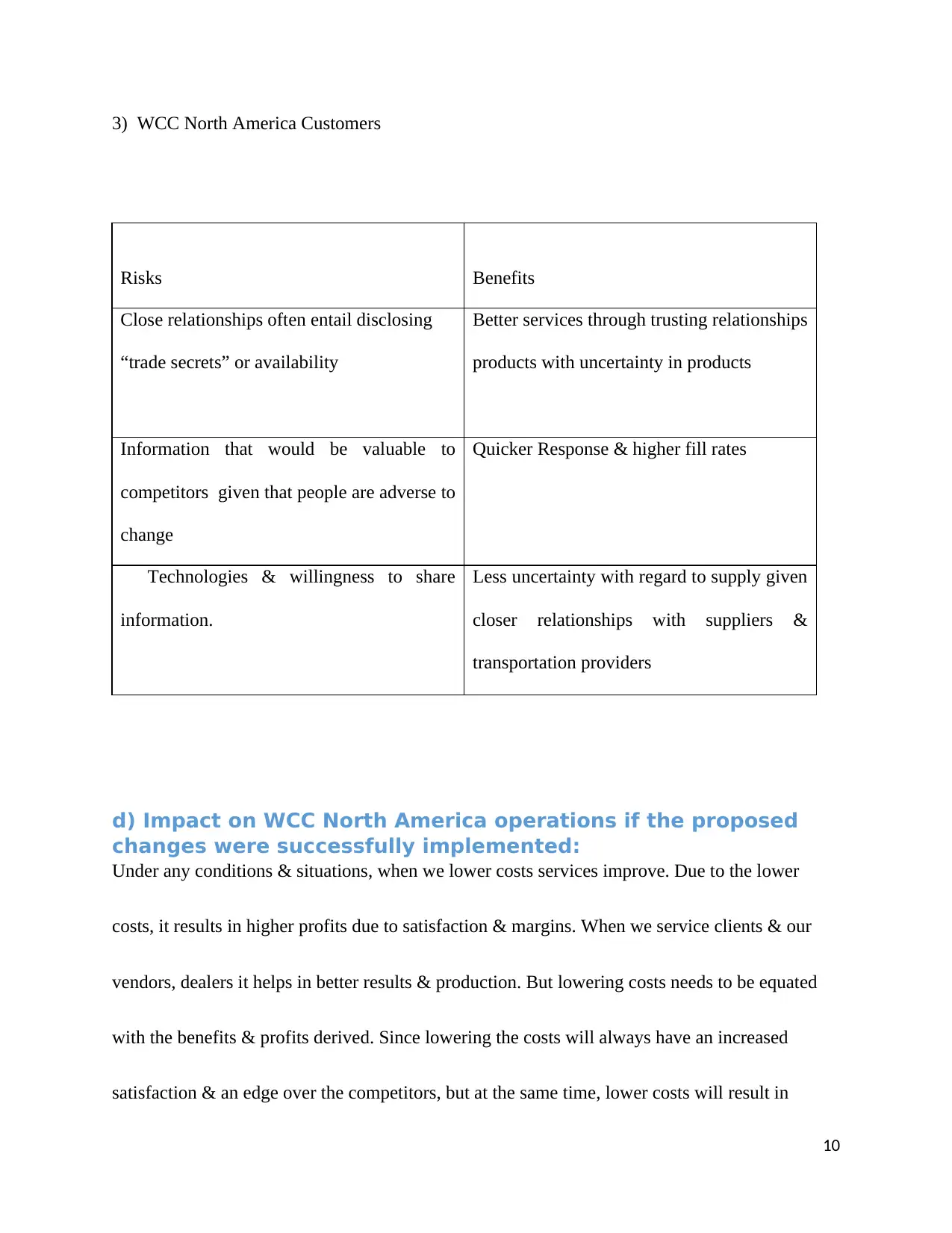
3) WCC North America Customers
Risks Benefits
Close relationships often entail disclosing
“trade secrets” or availability
Better services through trusting relationships
products with uncertainty in products
Information that would be valuable to
competitors given that people are adverse to
change
Quicker Response & higher fill rates
Technologies & willingness to share
information.
Less uncertainty with regard to supply given
closer relationships with suppliers &
transportation providers
d) Impact on WCC North America operations if the proposed
changes were successfully implemented:
Under any conditions & situations, when we lower costs services improve. Due to the lower
costs, it results in higher profits due to satisfaction & margins. When we service clients & our
vendors, dealers it helps in better results & production. But lowering costs needs to be equated
with the benefits & profits derived. Since lowering the costs will always have an increased
satisfaction & an edge over the competitors, but at the same time, lower costs will result in
10
Risks Benefits
Close relationships often entail disclosing
“trade secrets” or availability
Better services through trusting relationships
products with uncertainty in products
Information that would be valuable to
competitors given that people are adverse to
change
Quicker Response & higher fill rates
Technologies & willingness to share
information.
Less uncertainty with regard to supply given
closer relationships with suppliers &
transportation providers
d) Impact on WCC North America operations if the proposed
changes were successfully implemented:
Under any conditions & situations, when we lower costs services improve. Due to the lower
costs, it results in higher profits due to satisfaction & margins. When we service clients & our
vendors, dealers it helps in better results & production. But lowering costs needs to be equated
with the benefits & profits derived. Since lowering the costs will always have an increased
satisfaction & an edge over the competitors, but at the same time, lower costs will result in
10
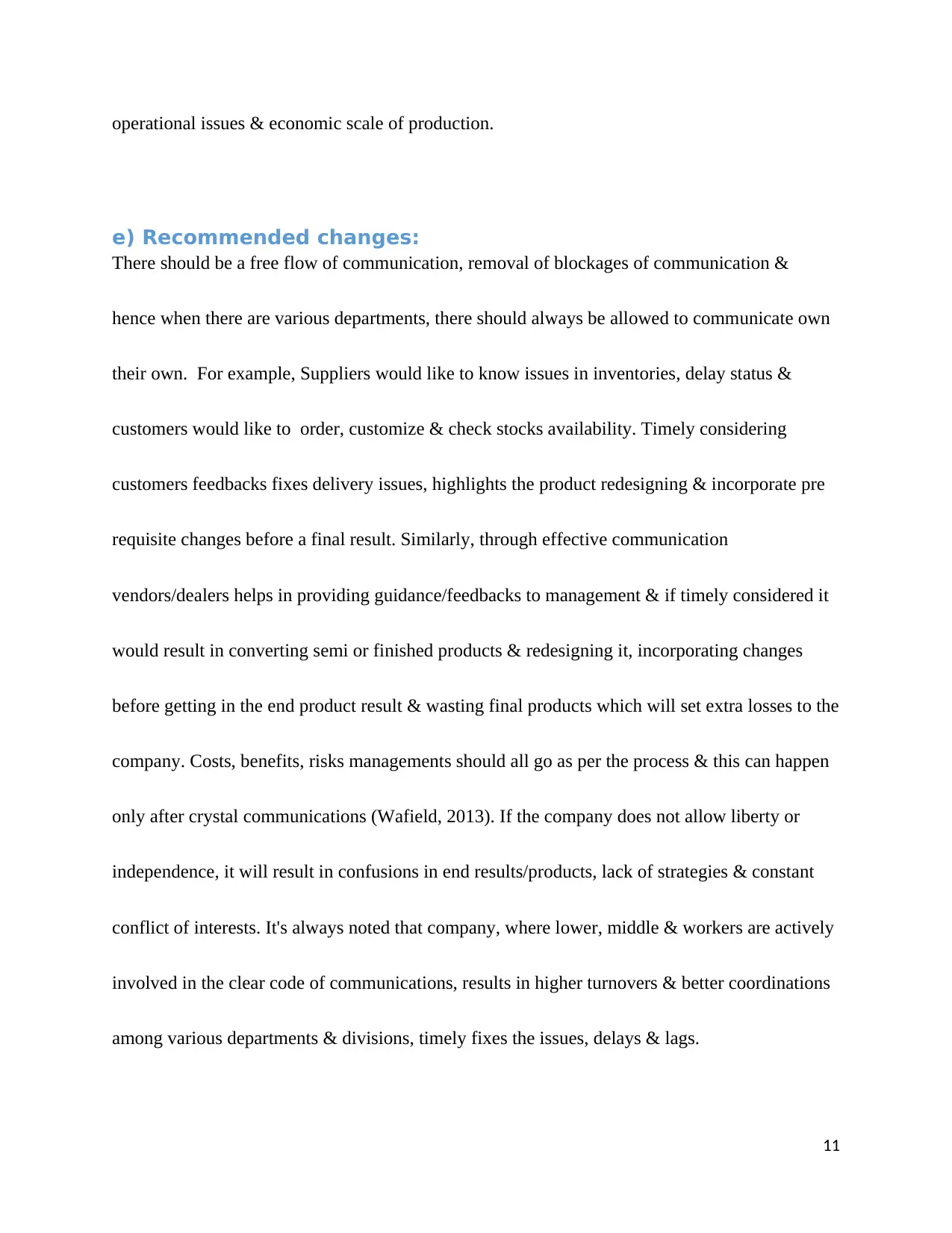
operational issues & economic scale of production.
e) Recommended changes:
There should be a free flow of communication, removal of blockages of communication &
hence when there are various departments, there should always be allowed to communicate own
their own. For example, Suppliers would like to know issues in inventories, delay status &
customers would like to order, customize & check stocks availability. Timely considering
customers feedbacks fixes delivery issues, highlights the product redesigning & incorporate pre
requisite changes before a final result. Similarly, through effective communication
vendors/dealers helps in providing guidance/feedbacks to management & if timely considered it
would result in converting semi or finished products & redesigning it, incorporating changes
before getting in the end product result & wasting final products which will set extra losses to the
company. Costs, benefits, risks managements should all go as per the process & this can happen
only after crystal communications (Wafield, 2013). If the company does not allow liberty or
independence, it will result in confusions in end results/products, lack of strategies & constant
conflict of interests. It's always noted that company, where lower, middle & workers are actively
involved in the clear code of communications, results in higher turnovers & better coordinations
among various departments & divisions, timely fixes the issues, delays & lags.
11
e) Recommended changes:
There should be a free flow of communication, removal of blockages of communication &
hence when there are various departments, there should always be allowed to communicate own
their own. For example, Suppliers would like to know issues in inventories, delay status &
customers would like to order, customize & check stocks availability. Timely considering
customers feedbacks fixes delivery issues, highlights the product redesigning & incorporate pre
requisite changes before a final result. Similarly, through effective communication
vendors/dealers helps in providing guidance/feedbacks to management & if timely considered it
would result in converting semi or finished products & redesigning it, incorporating changes
before getting in the end product result & wasting final products which will set extra losses to the
company. Costs, benefits, risks managements should all go as per the process & this can happen
only after crystal communications (Wafield, 2013). If the company does not allow liberty or
independence, it will result in confusions in end results/products, lack of strategies & constant
conflict of interests. It's always noted that company, where lower, middle & workers are actively
involved in the clear code of communications, results in higher turnovers & better coordinations
among various departments & divisions, timely fixes the issues, delays & lags.
11
⊘ This is a preview!⊘
Do you want full access?
Subscribe today to unlock all pages.

Trusted by 1+ million students worldwide
1 out of 15
Related Documents
Your All-in-One AI-Powered Toolkit for Academic Success.
+13062052269
info@desklib.com
Available 24*7 on WhatsApp / Email
![[object Object]](/_next/static/media/star-bottom.7253800d.svg)
Unlock your academic potential
Copyright © 2020–2025 A2Z Services. All Rights Reserved. Developed and managed by ZUCOL.



